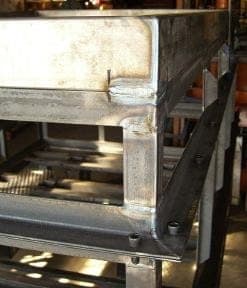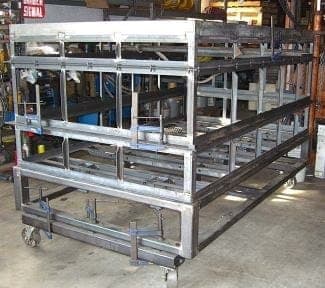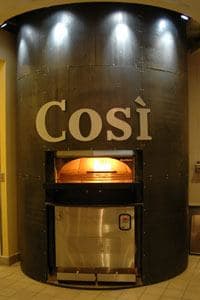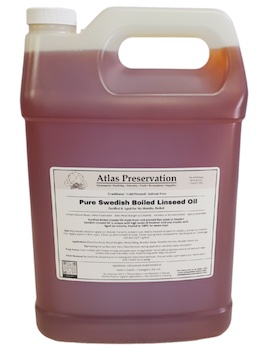
Curated with aloha by
Ted Mooney, P.E. RET

The authoritative public forum
for Metal Finishing 1989-2025

-----
Finish for Bare Steel
Q. [editor appended this entry to this thread which already addresses it in lieu of spawning a duplicative thread]
Hello, Can anyone comment on how long a steel object heat treated with linseed oil might stay substantially rust-free? Days, weeks, years? ... Obviously climate matters & I'm in the UK, so we're cool & reasonably rainy.
Many thanks
- West Sussex
August 1, 2024
A. This question was added to a thread where linseed oil as a temporary finish is discussed a bit. Jeffrey Holmes concludes the discussion with an informative response :-)

Ted Mooney, P.E. RET
Striving to live Aloha
finishing.com - Pine Beach, New Jersey
Q. Hi Thanks Ted.
Before posting I searched for appropriate posts and read that and other threads. Unless I've missed some content though, there's no mention anywhere about the durability of linseed oil on steel in a weathering environment?
part-time sculptor - West Sussex
August 2, 2024
A. Hi again, Jonathan, thanks for getting back to us, and letting us know that you are talking about sculpture.
The general proposition of temporary use was addressed by Jeffrey, with my inference being that linseed oil can be useful for a temporary need of maybe a couple of weeks if you are lucky. It is probably not a permanent solution.
Maintaining a raw, non-rusty, look over the long term in a non-arid environment is very difficult. 2-component automotive is probably the best approach. If you can accept a hot-dip galvanize look, however, that can be extremely robust, lasting decades.
This is a public forum, not a consulting service, so additional input from other readers is certainly welcome :-)
Luck & Regards,

Ted Mooney, P.E. RET
Striving to live Aloha
finishing.com - Pine Beach, New Jersey
A. Very good info on use of linseed oil as corrosion protective finish:
www.solventfreepaint.com/info/case_study_OrganicRustproofing.htm
Sunflower oil can be used too ... Hope it helps and good luck!
- Cerovski vrh Croatia
August 10, 2024
A. In your case that is question of maintenance, it is well known that even bronze sculptures must be periodically inspected, cleaned and waxed -- 2 times every year is minimum. Oil blackening disappeared after development of black oxide process, and I did not know if anybody tested its corrosion protective properties; and as you probably know, corrosion protection by black oxide is negligible. Hope it helps and good luck!
Goran Budija- Cerovski vrh Croatia
August 12, 2024
⇩ Related postings, oldest first ⇩
Q. I am working on a project where our client wishes to use mild steel on the front of a counter, however they want it to appear aged, and possibly slightly rusty (i.e., not new silver and shiny). What do I need to do to achieve this? What products do you recommend, that are available in New Zealand.
Christy Ormandarchitect - Auckland, North Island, New Zealand
2003
A. There are many ways to achieve this look. To blacken, either heat the metal to create a black oxide or apply a gunblue solution ⇦ this on eBay or Amazon [affil links] that can be purchased at a gun or sporting goods shop.
For rust, mist it with water -- the more water you apply the more rust, salt water greatly accelerates the rusting. Or apply an acid such as muriatic ⇦ this on eBay or Amazon [affil links] to the exposed steel to create rust. Muriatic can be bought at most hardware stores. To protect the finish apply an oil based lacquer or paint on a solution of boiled linseed oil ⇦ this on eBay or Amazon [affil links] , turpentine ⇦ this on eBay or Amazon [affil links] and beeswax ⇦ this on eBay or Amazon [affil links] to warmed metal for a darker finish. If the metal rusts too much, sand it lightly -- a thin layer of rust will protect the metal underneath. Have fun!
Fia Cooper- Vancouver, B.C., Canada
Clear Finish for Bare Metal
Q. A couple of years ago I welded a cart for my computer monitor etc. I stripped all the metal before I put it together with a wire brush with my angle grinder
⇦ this on
eBay
or
Amazon [affil links]
. I wanted to keep it natural metal so I decided to lacquer it. What has happened over the years is that the metal has darkened and in some places there are traces of rust. And the rust seems to be below the lacquer. What I wanted to find out is if I could have the whole cart dipped and stripped down the clean bare metal. And instead of using lacquer this time maybe try some sort of clear coat.
Is this even feasible?
I'm finding that locally (Columbus, Ohio) the dipping would be about $100 but I don't know where to begin researching any clear coat options or what to ask for.
Thank you.
Welding Hobbyist - Columbus, Ohio USA
2006
A. Good for you that you have such an excellent Computer cart...I need one..
I recommend you take it to an auto body shop. They have clear coat and other prep operations. Odds are the preparation was not good enough for the coating you used.
Next time consider using either boiled linseed oil or a tung oil
⇦ this on
eBay
or
Amazon [affil links]
product. Both are Mineral oil based and cover many prep mistakes.
- lake in the Hills, Illinois USA
January 11, 2011
Clear heat proof satin finish for mild steel kiln frame?
Q. We are completing a large glass fusing kiln (3' x 6' silicon carbide hearth), constructed within a mild steel frame with rolled mesh walls. The raw steel has a very attractive patina left over from TIG welding, which we would like to preserve. The outer skin temperature will probably range from a low of 150 °F to a high of 350 °F (in localized areas). Moisture from mold burnouts will eventually rust the steel, so we need some sort of "invisible" and moderately heat resistant protection. Being an old woodworker, the oil-rubbed look (e.g. boiled linseed oil
⇦ this on
eBay
or
Amazon [affil links]
) was first to come to mind. I am looking for equivalent finishes which are more metal-specific. Kiln frame s 4' x 8' x 6', so we need to brush or spray. Baking the finish (other than by natural heating) would not be easy, although we could employ hot air blowers or lamps if necessary.



Thank you very much,
Bruce D. Hubbard- Pasadena, California, USA
2006
A. 350 °F is in the range for some Novolac epoxies. Also check out Armco and Dampney for high temperature coatings.
Regards,
- Concord, California, USA
A. Another option is to use vegetable cooking oil; be careful as this will obviously flash and burn, but if you get the temp just right you can get that glazed look with it. Just heat the metal until the oil smokes when you apply it.
If I didn't say this before, this is a bit dangerous as you are working with hot metal and flammable liquid.
Blacksmith - Elizabeth City, North Carolina
Retaining the natural finish of exposed hot rolled steel structure in a new residence?

Q. Hi,
I'm an architect working on a residential project in CT and we want to expose the steel structure on the interior as a decorative, industrial detail. We are using hot rolled steel members and I would like to express the natural blue/brown/gray finish that is characteristic of the material, rather than priming and painting it which hides its natural beauty. The problem is this: if we erect the structure in the field, then frame the rest of the wood construction around it, it will be exposed to the elements for at least 2 weeks, and will likely rust which we don't want. I thought of wiping it down with vinegar
⇦in bulk on
eBay
or
Amazon [affil links] to clean the mill scale right after it's erected, then immediately applying a clear coat, but we are erecting it in December, and it's too cold to apply the clear coat before the space is enclosed. Can anyone tell me if a light sandblasting will remove the rust, but still leave enough of the original patina? Or if the sandblasting takes off the original color with the rust, is there another way to recreate that original finish through the application of a reactive chemical in the field? I appreciate any insight you can offer.
architect - Westport, Connecticut, USA
December 14, 2010
A. Steel will likely rust indoors as well as outdoors. The "natural" state of steel is red/brown iron oxide (rust), and if left to its own devices, steel (iron) will naturally revert to that state unless you prevent it.
Prevention means either preventing oxygen getting to it (and air is 20% O2), or by placing a sacrificial alternate metal in contact to "mop up" the oxygen.
One problem with most barrier systems (paints) is porosity. All paints are porous to some degree, so the main difference is how long it takes the air/water/moisture from air to get through and begin the rust.
For an industrial natural look you could consider hot dip galvanizing.

Geoff Crowley
Crithwood Ltd.
Westfield, Scotland, UK

A. You can probably accomplish what you want by wiping it down with boiled linseed oil ⇦ this on eBay or Amazon [affil links] which will polymerize and harden over a period of weeks. If you can apply multiple coats a few weeks apart, even better. If you still get some orange/red rust from exposure to water, rubbing with a coarse cloth and linseed oil will restore the finish.

Jeffrey Holmes, CEF
Spartanburg, South Carolina
Q, A, or Comment on THIS thread -or- Start a NEW Thread
